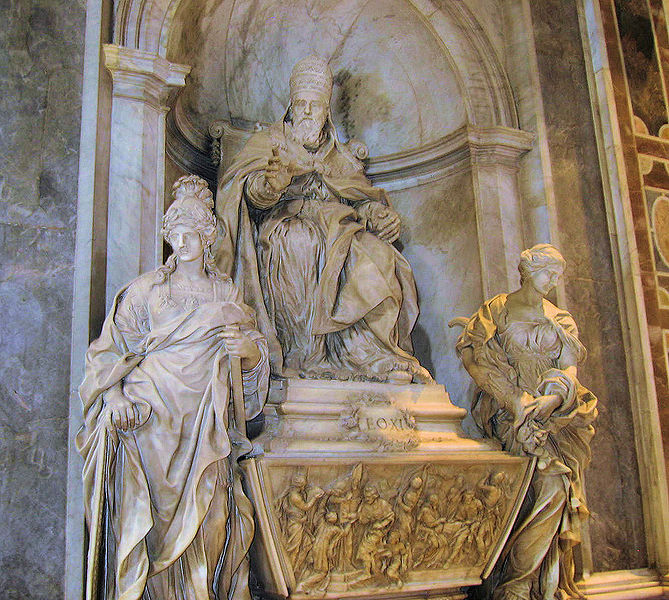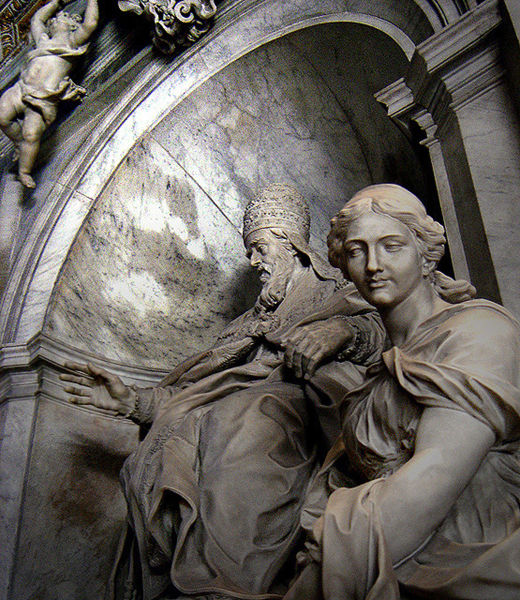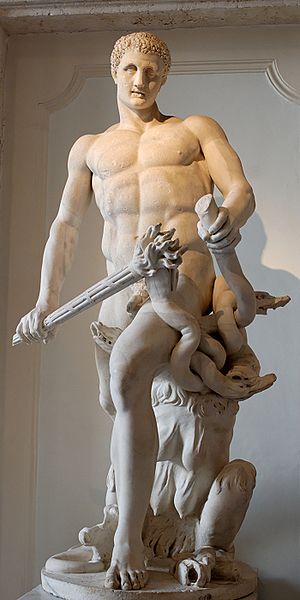<Back to Index>
- Mathematician Gabriel Cramer, 1704
- Sculptor Alessandro Algardi, 1598
- Holy Roman Emperor Maximilian II, 1527
Algardi was born in Bologna, where at a young age, he was apprenticed in the studio of Agostino Carracci. However, his aptitude for sculpture led him to work for Giulio Cesare Conventi (1577—1640), an artist of modest talents. By the age of twenty, Ferdinando I, Duke of Mantua, began commissioning works from him, and he was also employed by local jewelers for figurative designs. After a short residence in Venice, he went to Rome in 1625 with an introduction from the Duke of Mantua to the late pope's nephew, Cardinal Ludovico Ludovisi, who employed him for a time in the restoration of ancient statues. Propelled by the Borghese and Barberini patronage, Gian Lorenzo Bernini and his studio garnered most of the major Roman sculptural commissions. For nearly a decade, Algardi struggled for recognition. In Rome he was aided by friends that included Pietro da Cortona and his fellow Bolognese, Domenichino. His early Roman commissions included terracotta and some marble portrait busts, while he supported himself with small works like crucifixes.
Algardi's first major commission came about in 1634, when Cardinal Ubaldini (Medici) contracted for a funeral monument for his great-uncle, Pope Leo XI, the third of the Medici popes, who had reigned for less than a month in 1605. The monument was started in 1640, and mostly completed by 1644. The arrangement mirrors the one designed by Bernini for the Tomb of Urban VIII (1627-8), with a central hieratic sculpture of the pope seated in full regalia and offering a hand of blessing, while at his feet, two allegorical female figures flank his sarcophagus. However, in Bernini's tomb, the vigorous upraised arm and posture of the pope is counterbalanced by an active drama below, wherein the figures of Charity and Justice are either distracted by putti or lost in contemplation, while skeletal Death actively writes the epitaph. Algardi's tomb is much less dynamic. The allegorical figures of Magnanimity and Liberality have an impassive, ethereal dignity. Some have identified the helmeted figure of Magnanimity with that of Athena and iconic images of Wisdom. Liberality resembles Duquesnoy's famous Santa Susanna, but rendered more elegant. The tomb is somberly monotone and lacks the polychromatic excitement that detracts from the elegiac mood of Urban VIII's tomb.
In 1635-38, Pietro Boncompagni commissioned from Algardi a colossal statue of Philip Neri with kneeling angels for Santa Maria in Vallicella, completed in 1640. Immediately after this, Algardi produced an interactive sculptural group representing the beheading of Saint Paul with two figures: a kneeling, resigned saint and the executioner poised to strike the sword-blow, for San Paolo di Bologna.
These works established his reputation. Like Bernini's characteristic
works, they often express the Baroque aesthetic of depicting dramatic
attitudes and emotional expressions, yet Algardi's sculpture has a
restraining sobriety in contrast to those of his rival. With the death of the Barberini Pope Urban VIII in 1644 and the accession of the Pamphilj Pope Innocent X,
the Barberini family and their favorite artist, Bernini, fell into
disrepute. Algardi, on the other hand, was embraced by the new pope and the pope's nephew, Camillo Pamphilj. Algardi's portraits were highly prized, and their formal severity contrasts with Bernini's more vivacious expression. A large hieratic bronze of Innocent X by Algardi is now to be found in the Capitoline Museums. Algardi
was not renowned for his architectural abilities. Although he was in
charge of the project for the papal villa, the Villa Pamphili, now Villa Doria Pamphili,
outside the Porta San Pancrazio in Rome, he may have had professional
guidance on the design of the casino from the architect/engineer Girolamo Rainaldi and help with supervising its construction from his assistant Giovanni Francesco Grimaldi. The
casino was a showcase for the Pamphili collection of sculpture, ancient
and contemporary, on which Algardi was well able to advise. In the
villa grounds, Algardi and his studio executed sculpture-encrusted
fountains and other garden features, where some of his free-standing
sculpture and bas-reliefs remain. In 1650 Algardi met Diego Velázquez, who obtained commissions for his work from Spain. As a consequence there are four chimney-pieces by Algardi in the Royal Palace of Aranjuez, and in the gardens, the figures on the fountain of Neptune are also by him. The Augustinian monastery at Salamanca contains the tomb of the Count and Countess de Monterey, another work by Algardi. Algardi's large dramatic marble high-relief panel of Pope Leo and Attila (1646–53) for St Peter's Basilica was
widely admired in his day, and reinvigorated the use of such marble
reliefs. There had been large marble reliefs used previously in Roman
churches,
but for most patrons, sculpted marble altarpieces were far too costly.
In this relief, the two principal figures, the stern and courageous
pope and the dismayed and frightened Attila,
surge forward from the center into three dimensions. Only they two see
the descending angelic warriors rallying to the pope's defense, while
all others in the background reliefs, persist in performing their
respective earthly duties. The
subject was apt for a papal state seeking clout, since it depicts the
historical legend when the greatest of the popes Leo, with supernatural
aid, deterred the Huns from looting Rome. From a baroque standpoint it is a moment of divine intervention in the affairs of man. No doubt
part of his patron's message would be that all viewers would be sternly
reminded of the papal capacity to invoke divine retribution against
enemies. Algardi died in Rome within a year of completing his famous relief, which was admired by contemporaries. In
his later years Algardi controlled a large studio and amassed a great
fortune. Algardi's classicizing manner was carried on by pupils
(including Ercole Ferrata and Domenico Guidi). Antonio Raggi initially trained with him. The latter two completed his design for an altarpiece of the Vision of Saint Nicholas (San Nicola da Tolentino, Rome)
using two separate marble pieces linked together in one event and
place, yet successfully separating the divine and earthly spheres.
Other lesser known assistants from his studio include Francesco Barrata, Girolamo Lucenti, and Giuseppe Peroni. Algardi was also known for his portraiture which shows an obsessive attention to details of psychologically revealing physiognomy in a sober but immediate naturalism,
and minute attention to costume and draperies, such as in the busts of
Laudivio Zacchia, Camillo Pamphilj, and of Muzio Frangipane and his two
sons Lello and Roberto. In temperament, his style was more akin to the classicized and restrained baroque of Duquesnoy than
to the emotive works of other baroque artists. From an artistic point
of view, he was most successful in portrait-statues and groups of
children, where he was obliged to follow nature most closely. His
terracotta models, some of them finished works of art, were prized by
collectors.




